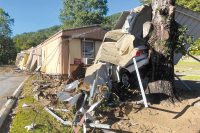Bring in the army: Initiative will link allies in fight against hemlock wooly adelgid
 As stand after stand of towering hemlocks falls to the appetite of an insect smaller than a grain of rice, foresters and wildlife managers alike are scrambling for an answer to the hemlock wooly adelgid.
As stand after stand of towering hemlocks falls to the appetite of an insect smaller than a grain of rice, foresters and wildlife managers alike are scrambling for an answer to the hemlock wooly adelgid.
The invasive pest is still chomping steadily through Appalachian forests, threatening to forever alter the ecological landscape of the mountains.
Millions of dollars have been spent over the past decade to save the anchor tree species, but the new Hemlock Restoration Initiative hopes to bring the adelgids’ reign to an end by 2025.
The initiative is being spearhead by N.C. Agriculture Commissioner Steve Troxler through the Department of Agriculture and Consumer Services. A $100,000 grant to kick-start the initiative was awarded from the state’s multi-million dollar legal settlement with the Tennessee Valley Authority, an environmental funding pool stemming from a federal air pollution lawsuit.
Related Items
Strength in numbers
The initiative’s power is not necessarily in the money, though. It’s in the approach.
The idea is to encourage collaboration and synergy between scientists and land managers who have been exploring different routes of attack against the insect — releasing predator beetles, inoculating signature groves or breeding adelgid-resistant strains of hemlock.
“We’re all out here on our own with a limited budget. There’s a lot of wasted effort,” said Bill Yarborough, special assistant for NCDACS in Western North Carolina. “This is essentially bringing an army together to attack the enemy.”
By getting scientists working together, WNC Communities, a community development nonprofit managing the initiative, is hoping to connect the dots.
They don’t want to “reinvent the wheel,” said L.T. Ward, vice president of WNC Communities, “but to encourage those who are already in research work to address that need.”
Over the next two months, WNC Communities will be assembling researchers, explaining goals and otherwise laying the groundwork for the program before any money is actually granted.
If the program is successful — which its supporters unequivocally expect it to be — it will likely be given more money in the future.
“We don’t expect it to be a one-shot deal,” said Ward. “We expect the current project to lay the groundwork.”
As WNC Communities works locally to identify the projects most worthy of funding, Troxler will be leveraging some capital of his own. A past president of the National Association of State Departments of Agriculture, he has plenty of contacts spread across the nation. Troxler plans to use those connections to unite research efforts from all states.
“We now have one of the top officials in North Carolina, Agriculture Commissioner Steve Troxler, recognizing the need and urgency of the hemlock challenge and providing additional funding to accelerate solutions. Hemlocks have never had such a strong ally before,” said George Ivey, who will serve as the hemlock project coordinator and is from Haywood County.
No time to waste
When it comes to the hemlock, Yarborough said, there’s no room for competition between agencies or scientists facing the same problem.
“The loss of this tree is the most significant loss since the American chestnut,” he said. “It will change Western North Carolina as well as the other parts of its habitat. You can ride around now and see all those gray ghosts all over Western North Carolina.”
The hemlock is a frequently-occurring tree in Western North Carolina — “I don’t know if you could go anywhere in Western North Carolina and get a quarter of a mile in any direction that you won’t find a dead or dying hemlock,” Yarborough said — and it fills some pretty vital ecological roles.
Plenty of animal species depend on the cool, dense forests hemlock creates, and the year-round shade the evergreen trees provide is important to aquatic species as well.
“What’s going to happen is trout streams are going to warm up, and that could impact our native trout as well as the bugs that live in the stream,” Yarborough said.
A 2013 USFS study indicated that losing the hemlock could permanently change the region’s water cycle, as well, because the large trees photosynthesize year-round, helping to regulate water flow.
“The things that we don’t even consider are certainly part of this whole loss,” Yarborough said.
But Yarborough is hopeful that the initiative will make it possible for hemlock trees to resist the adelgid in the wild by the project’s target of 2025. That’s a mere 11 years away, but Yarborough isn’t the only one who believes the goal is within reach.
“I think it’s possible,” said Kristine Johnson, supervisory forester in Great Smoky Mountains National Park.
Part of Johnson’s job is managing research activities in the park, particularly those dealing with forest insects and disease. There’s nary a section of the park whose hemlocks are unaffected by the adelgid, but she’s seen science make great strides even over the last decade or so.
“What we know now, if we knew that ten years ago, we would have been able to save so many more trees, but the science and art of large-scale treatments for hemlock had never been done before,” she said.
It takes time to develop the know-how to combat a new threat, and the collaborative approach that the Hemlock Restoration Initiative will promote is a necessary tool to move that timeline forward, she said.
“We don’t have much time to save large amounts of hemlocks,” Johnson said. “It’s crucial that everyone has the best information they can and works together.”
Sometimes, though, that’s difficult. Scientists and researchers are typically funded just for one particular project, often with a narrow focus, so by design they’re not seeing the whole view. That makes it important to have a group of people charged with looking at the top view.
“It’s important to have people who are unbiased and are really focused on the big picture,” Johnson said.
A forest of unknowns
But it’s not a problem that can be conquered with a formula or smothered with bureaucracy. Ecology doesn’t move in a straight line.
“There’s a lot that we don’t know about how this will progress,” Johnson said. “We do know that in a severe infestation, trees can die in two or three years, but if we have cold winters and moisture in the summer, the trees can be healthy. There can be genetic resistance within the population. We don’t know how it’s going to play out.”
Sometimes, that play is full of surprises. Nature tossed the hemlocks a bone this winter, when an extra-cold season gave the bugs a beating. In the four high-altitude sites that researchers monitored in the park, frigid temperatures left 80 to 90 percent of hemlock wooly adelgids dead.
Then, of course, there’s the supply-and-demand end of things. When the adelgids first descended on the hemlock-rich Appalachians in the late 1990s, they encountered a feast. Their numbers swelled accordingly, leaving the mountains in the state they are now. But that’s not a permanent situation.
“Typically when you have an introduction of a forest pest like that, there’s an outbreak period, and then in time things do naturalize,” Johnson said. “It can’t stay in outbreak period for centuries or even decades.”
For starters, the insects eventually eat through their food source.
Johnson points to the balsam wooly adelgid, which began attacking Fraser fir trees in the 1950s. Within a couple of decades, forests lost 70 to 80 percent of their Fraser firs, but eventually the insects hit a ceiling and began to decline. Now, the Fraser firs are growing again.
But that doesn’t mean that it’s OK to just sit and wait. In the case of the Fraser firs, the number of trees growing now is nothing compared to the share of the forest Frasers held in the 1940s.
And the trees that are coming back, of course, are still small. It will be a long time before they can be considered old growth.
“An old-growth hemlock will be a great treasure in 2025,” Johnson said. “I would say there will still be a few. I hope so.”
The Smokies has spent hundreds of thousands, in large part through grants, to chemically inoculate some of its most prized hemlock stands. It’s a labor intensive process, and must be repeated every several years, but it could buy time for key hemlock groves until a more permanent solution is found.
By banding researchers together, drawing on the synergy that forms when great minds share a room and doling out the resources they need to produce answers, Yarborough hopes to see that number rise above “a few.”
“There’s not much of anything that can’t be done if you have a concerted effort to do it,” he said.
What is the hemlock wooly adelgid?
The hemlock wooly adelgid is a small, aphid-like insect that feeds on the fluids trees use for food. The nymphs settle at the bases of hemlock needles, where they spend the winter feeding on the tree’s starches until reaching maturity. Infestation can cause needles to drop and branches to die. Death of the tree may take as long as a decade, but it’s a virtual certainty.
The adelgid, a native to Asia, first came to the northwestern U.S. in 1924, and eventually reached WNC in the early 2000s.









